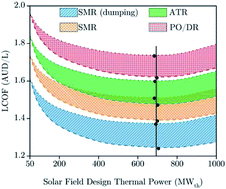Methanol fuel production from solar-assisted supercritical water gasification of algae: a techno-economic annual optimisation
Abstract
Methanol synthesis offers a relatively fast transient response compared to other fuel synthesis technologies—a promising downstream alternative for solar-derived syngas. However, many non-intuitive design choices must be analysed to achieve an optimal techno-economic performance of this technology in the presence of variable solar energy. Using a combination of steady-state Aspen flowsheeting, dynamic simulation and techno-economic optimisation, this work presents the techno-economic performance of methanol production through solar-thermal supercritical water gasification (SCWG) of algae with three alternative methane reforming options. The syngas is conditioned for downstream use through either CO2 dumping or H2 addition. In a multi-objective optimisation, solar multiple and storage capacity are varied to minimise the levelised cost of fuel (LCOF) and maximise the capacity factor of the system. Results indicate that steam methane reforming (SMR) with CO2 dumping gives a minimum LCOF of ∼1.6 AUD per L. The lowest-cost reforming option changes if the cost of renewable H2 drops. Achieving high capacity factor (>98%) configurations requires large storage and causes LCOF to increase 4–5×. Scaling up the solar-thermal collector to 700 MWth yields LCOF reductions of ∼20% relative to the baseline 50 MWth scale, beyond which optical losses outweigh scaling benefits. Overall, the choice of methanol for downstream fuel synthesis appears to be beneficial due to its faster ramping and overall increased output compared to Fischer–Tropsch synthesis.



 Please wait while we load your content...
Please wait while we load your content...